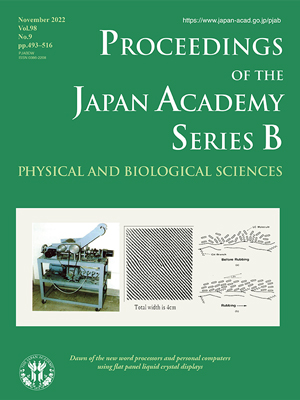About the Cover
Vol. 98 No. 9 (2022)
Twisted nematic (TN) LCDs, which have come to be used in digital watches and pocket calculators since 1973, are characterized by their lightness, thinness and low power consumption. Initially, a segment scheme that uses a duty-cycle driving was used, but their information content has been limited to 7-dot alphanumeric format. In 1978, the TN-type matrix display was released to meet the expansion of the information content, and in 1982, a matrix display of 480 columns × 128 lines with a 1/64 duty cycle was achieved with the TN mode. However, sufficient contrast ratio could not be obtained with higher information content, and the development to improve image quality ran into a deadlock. Under these circumstances, the super twisted nematic (STN) LCD was invented and the replacement of cathode ray tube (CRT) displays with LCDs started. In the following paragraph, I will explain how this historic innovation took place.
In 1984, Terry Scheffer and Jürgen Nehring invented 540 × 270 dot matrix STN LCD; this brought a sign of replacing the bulky and heavy CRTs with LCDs. However, the STN LCD had two problems: one was a yellow colored indication with a green colored background and the other was the appearance of a defect called stripe domain, which is shown in the left of the drawing. These defects largely degrade contrast ratio in the black and white STN LCD when the pretilt angle is as low as 2–3 degrees, which is common in TN LCDs. For eliminating these defects, two inventions were done; one was that of a rubbing machine (invented in 1972–1973) shown as a photo, and the other was done by Hiroyoshi Fukuro and Shunsuke Kobayashi (see the review article in this issue pp. 493–516): surface modification of the alignment layer by introducing alkyl-branches into polyimide chains as shown in the right part of the drawing (a). By using this rubbing machine, Fukuro and Kobayashi succeeded in realizing the defect-free STN LCDs for the first time by generating a high pretilt angle of 7–10 degrees as shown in the drawing (b) in 1986–1987. The use of this machine brought the age of LCD-word processors and personal computers with the efforts of realizing black and white STN LCDs by eliminating yellow-green color STN LCDs by Japanese companies.
Rubbing machines with the same structure and working principle are currently used in every laboratory and factory worldwide. This original rubbing machine is preserved in the Memorial Room of RIKEN for celebrating its 100-years anniversary.
Shoichi Ishihara
Honorary Member of the Japanese Liquid Crystal Society




